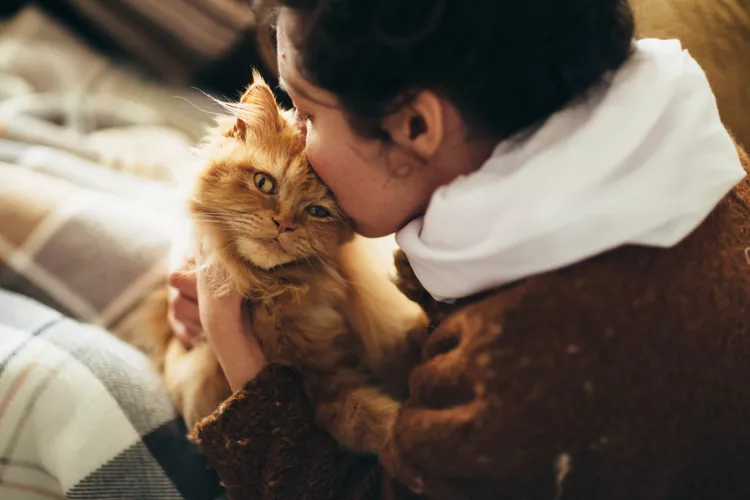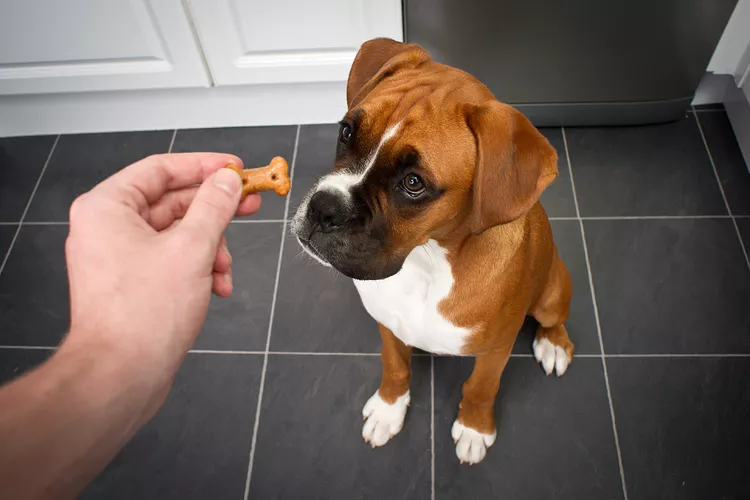
Is your dog afraid of the stairs? Some dogs are afraid of going up and down stairs. This is a fairly common fear or phobia, especially in young dogs who may not have encountered them while they were puppies. Fortunately, you can help your dog get over this fear and go up and down the stairs with confidence. Here's what you need to know if your dog has a fear of the stairs.
Before you begin searching for behavioral issues that may cause a dog's fear of stairs, talk to your veterinarian. Your dog's fear may stem from a physical problem. He may not want to go up and down the stairs because it causes him pain (in cases of arthritis or an injury). Have your veterinarian rule out a medical condition before you start any training.
Many dogs who are afraid of stairs develop the fear because of a lack of early exposure. If you live in a single story home, it's possible that your dog won't see stairs until a little later in life. Some dog owners may have discouraged their puppies from going on the stairs to keep them contained to a limited area.
In some instances, a dog may develop a fear of stairs from a traumatic experience. For example, a dog who falls down the stairs may be left with a phobia of climbing stairs.
Most of the time, a dog's fear of stairs is easy to overcome. The following tips can help you navigate the process:
Remember to be patient with your dog. Depending on its level of fear, it may take some time for it to get comfortable with the stairs. Work in short, upbeat training sessions. If your dog seems overwhelmed, frustrated, bored, or stressed, it's time to end the session. Always try to end on a positive note. If you find that your dog's phobia is too intense to overcome, it's a good idea to seek help from a dog trainer or behaviorist. You can ask your vet for recommendations to help you find the right professional.
Edited by Jenna Stregowski, RVT

Cute Pictures & Facts About Calico Cats & Kittens
Learn fascinating facts about calico cats, including photos, the genetics behind this color combination, and common folklore and traditions.
How to Prevent Cat Separation Anxiety During Vacations
Discover why cats develop litter box problems and cat behavior problems when you go on vacation and what you can do about it to help them.
Cat Behavior Changes That Might Mean Something's Wrong
Cats' behavioral changes may indicate problems—or they may mean nothing at all. Explore causes of odd behavior and what to do about them.
Lhasa Apso: Dog Breed Characteristics & Care
The Lhasa apso is an ancient breed from Tibet that was bred to be a watchdog. Learn about its history, health, exercise needs, and more.
Reasons Why Dogs Run Away and How to Stop It
Dogs can escape, especially if they’re bored and not properly contained. Here are some techniques for stopping your dog from running away.
Can Dogs Get Depression? How to Help Your Sad Dog
Can dogs get depression? Learn about the signs of depression in dogs and find out how to help your sad dog.
How to Stop Aggression in Dogs
Dog aggression can be a serious behavior issue for pet owners. Learn how to stop aggression in dogs before someone gets hurt.
How to Stop Your Dog From Growling
A growling dog can soon become even more aggressive. Reduce the noise and potential for a dangerous situation with some of these techniques.
Why Do Dogs Dig Holes? How to Stop Your Dog from Relandscaping Your Yard
Dogs have been digging holes for centuries and for many reasons. Whether they’re bored or want to cool off in the dirt, here are the top reasons why dogs dig holes.
Dog Treat Varieties
Learn about the different types of dog treats on the market and decide which are best for your dog.
Can Dogs Eat Asparagus?
Dogs can eat asparagus, provided the vegetable is cooked plain and cut up for them. Seasonings, salt, and butter make it unhealthy for dogs.
Histiocytomas in Dogs
A histiocytoma is a type of benign (non-cancerous) skin lump that usually affects young dogs. Learn the causes, treatment, and prevention.
Why Is My Dog’s Eye Swollen?
If your dog's eye is swollen, she may need veterinary attention. The inflammation could be caused by allergies, an injury, or even a tumor.
Common Bugs and Parasites Found on and Inside Dogs
Learn about common types of parasites in dogs. Find out how to treat and prevent parasites to keep your dog, your family, and yourself safe.
Exploring the Different Types of Pet-Friendly Beaches
Are you looking for pet-friendly beaches? Learn about the different types of pet-friendly beaches, their locations, and tips for visiting them with your pet.
10 Obscure, Little-known Canine Facts in Honor of National Dog Day
With National Dog Day upon us, it's time to celebrate everything about our favorite pets—even the weirder stuff. Here are 10 obscure facts about dogs you probably didn't know.
Kitten Development From 3 to 6 Months Old
Kittens grow and change a lot during their first year. Find out what happens between the ages of three months and six months old.
95 Siamese Cat Names
Our list of Siamese cat names has diverse and fun options to help you choose the ideal moniker for your elegant and lovable feline companion.
What to Buy for Your New Cat: A List of Essentials
Before you bring your new cat or kitten home, there are a number of things to collect or buy so your cat will feel welcomed like a family member.
The 6 Best Cat Nail Clippers of 2024 for a Safe Trim
Clipping your cat's nails can save your furniture and keep your kitty comfortable. We asked veterinarians for their cat nail clipper recommendations.